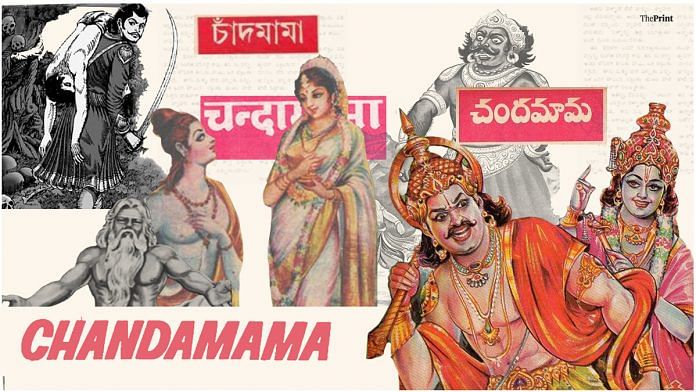Poonam Sharma, a teacher in Gautam Buddh Nagar, makes it a point to tell her daughters a story every night before they sleep. “Kids imagine themselves to be protagonists of the stories they hear,” she says, while emphasising on the importance of stories to teach kids about morals and ethics without patronising them.
Poonam credits her fascination for stories to Chandamama, the magazine that gave her and many others tons of fascinating stories of different kinds, with an underlying moral hidden in every story.
The monthly magazine featured folktales, mythological tales (like stories from Mahabharata, Ramayana, Baital Pachisi and Vishnu Puran), stories sent in by readers and moral stories along with current events from different states of India and fun facts about the various cultures. It was information and entertainment packaged in the style of a comic book, with fonts and illustrations that made even heavier content easily digestible.
Also read: Hum Log, India’s first soap opera and DD’s experiment with foreign cinema
From the Independence era
Chandamama was first published in July 1947 in Telugu and Tamil (as Ambulimama) by filmmakers B. Nagi Reddy and Chakrapani. In 1949, it began to be published in Kannada and Hindi, and by the 1990s, Chandamama had been published in 13 languages, including Marathi, Malayalam, Gujarati and English.
Gopi Shah, a singer based in Mumbai, tells ThePrint that Chandamama played an extremely important role in her childhood. It developed her cultural sensibilities and reading habits and gave her a greater understanding of the world around her. Shah recalls how the knowledge acquired from the books allowed her to be a bit of a show-off in front of her peers. “I was a bookworm, but my friends weren’t so they’d sit around me while I told them tales I had read in the different comics,” she reminisces.
“As a kid I was fascinated by reading these stories and looking at illustrations of how people lived in Assam, Kashmir and other places right from the comfort of my house,” she enthuses.
The magazine became such an obsession for Poonam Sharma and her sister that they’d fight every time it came home in a bid to read it first– without the story getting spoilt by their neighbours (the truce generally would be reached by taking turns to read each story). They’d then use this material to improvise and perform skits of their own by taking on the roles of tigers, bears, kings and queens mentioned in the stories.
Also read: Planet M — brand that changed how Indians experienced music in new millennium
No longer published but still alive
Chandmama hit its peak in the 1970s and ’80s. Then, with the arrival of newer comics, TV and other sources of entertainment, its popularity began to decline.
In October 1998, the magazine was suspended for a year even though its circulation figures were steady at about half a million. In an interview with Mint in 2008, L, Subramanian, who had just become the CEO of Geodesic, a software services company that had bought 94 per cent of the magazine’s stakes the previous year, explained that a workers’ strike at Nagi Reddy’s film studio led to Chandamama becoming a casualty.
With big plans of relaunching the magazine, Geodesic revamped its design and even made it available on iOS. But this new lease of life was short-lived thanks to lack of funds, and then Geodesic faced provisional liquidation for tax fraud and siphoning of funds.
According to a report, almost 6,000 copies of hand-illustrated stories, copies of the magazine, 640 print episodes of Vikram Betal and other documents lie bundled in sacks in Geodesic’s office in Mumbai.
But even though it is defunct, Chandamama still has fans taking care of its legacy. An unofficial website is a bid by volunteers and lovers of the cult magazine from all over India to digitise and preserve its stories. Issues of the magazine dating all the way back to 1947 have been uploaded on the website in different languages.
Also read: The KamaSutra ad that changed the role of condoms in India from functional to pleasurable




Hello Sirs, Is it possible to get the old chandanama malayalam – Ambili Ammavan editions i.e from 1960 to 1980 either digital or hard copy ?
Shall be thankful for your feedback.
Suresh, Kerala,
9995226754
I had the privilege of working for the English edition of the magazine between 1973 and 1974, my first job, in then Madras. All the originals were first written in Telugu, the mother tongue of promoters Nagi Reddy and his best friend Chakrapani, with occasional original input from other languages. Chakrapani seems to have played significant role in its formative years, later writers Kodavatiganti Kutumba Rao and DasarI Subramanyam have written and rewritten stories from the original Telugu, and then translated into different languages. The magazine had enormous fan following. Two legendary illustrators drew the figures, sadly unable to recall their names. Years after I had left the magazine, written to my then boss Viswam, Nagi Reddy’s son, of the myriad opportunities to use the wealth of knowledge in its pages to bring out multitude of products, collected volumes of loved stories, as CDs/DVDs, films, and in many other forms. He responded but nothing ever happened thereafter, and I was sad to learn of its demise, and the non-use of its wealth. Somebody should explore these products. Its value is eternal.
Excellent informative article.